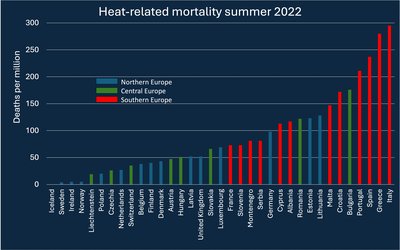
Over the past decade, a new field of science called “extreme event attribution” has emerged, which allows for answering the question: did climate change play a role in this specific extreme event? Many attribution studies of recent hot extremes find a dominant contribution of anthropogenic climate change to their probability of occurrence. For example, human-induced climate change increased the likelihood of the record hot Australian summer of 2012/2013 by at least five times and the record warm Central England temperature of 2014 by at least 13 times.
It might be expected that record warm events in previous decades may also be attributable to human-induced climate change. This was studied for observational data sets of large parts of the world, back to 1900. It turns out that the effect of climate change on extreme events extends back several decades. An example is the record- breaking hot summer of 1997/1998 in Australia. The study was carried out for both record-breaking hot years and record-breaking hot summers. The results for both hot years and hot summers are similar: the likelihood of record hot events due to anthropogenic influences has increased. Many past record hot summers have a substantial fraction of their probability of occurrence attributable to anthropogenic climate change, including high profile events such as the 2003 hot European summer.
Whether or not an anthropogenic influence can be discriminated from interannual temperature variability depends on the size of the anthropogenic effect with respect to the size of variability. Interannual variability reduces with an increase of the spatial scale of a study. Thus, for time series representing larger regions of the world the imprint of an anthropogenic influence extends further back as interannual variability is reduced allowing the anthropogenic signal to appear earlier. The largest spatial scale is a global series of observations: all of the last 16 record hot years in this global series, starting as early as 1937, have a fraction of their probability of occurrence attributable to the anthropogenic influence on the climate.
Another interesting feature is the fact that in the middle of the twentieth century the likelihood of hot years reduces in the Northern Hemisphere. This effect is related to anthropogenic aerosols reducing the likelihood of hot years. The effect of anthropogenic greenhouse gases supersedes that of anthropogenic aerosols in later decades leading to an increase in the likelihood of hot years related to the total anthropogenic influence. In Australia, where the anthropogenic aerosol effect is weaker, the emergence of an anthropogenic influence, due to greenhouse gas emissions, is earlier.
Source: King et al., 2016. Geophysical Research Letters 43: 3438-3443.
Photo: Simon K (www.flickr.com)








